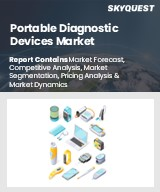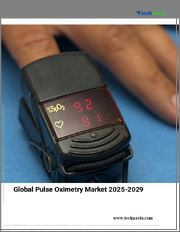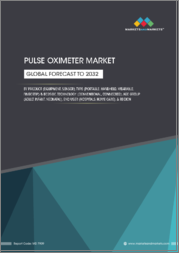
|
시장보고서
상품코드
1435535
경피적 산소농도 측정 시스템 : 시장 점유율 분석, 산업 동향 및 통계, 성장 예측(2024-2029년)Transcutaneous Oximetry Systems - Market Share Analysis, Industry Trends & Statistics, Growth Forecasts (2024 - 2029) |
||||||
경피적 산소농도 측정 시스템 시장 규모는 2024년에 1억 3,717만 달러로 추정되며, 2029년에는 1억 8,627만 달러에 달할 것으로 예상되며, 예측 기간(2024-2029년) 동안 연평균 6.31%의 CAGR로 성장할 것으로 예상됩니다.
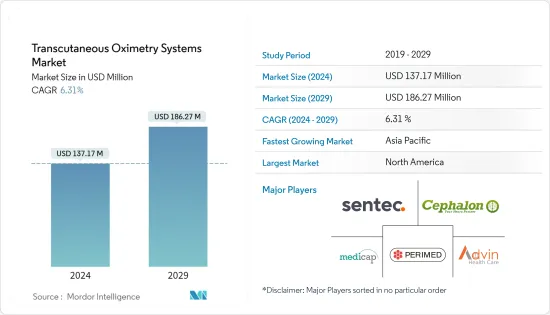
COVID-19 전염병은 신종 코로나 바이러스 감염 환자의 산소 농도가 급격히 감소하여 경피적 산소농도 측정 시스템에 큰 영향을 미쳐 지속적인 모니터링이 필요하게 되었습니다. 예를 들어, 2021년 6월 BMC 저널에 게재된 논문에 따르면, COVID-19 팬데믹 기간 동안 입원 환자의 산소 농도를 파악하기 위해 경피적 맥박 산소농도 측정이 시행되었습니다. 따라서 COVID-19 감염병의 대유행은 초기에 시장에 긍정적인 영향을 미쳤으나, 대유행이 진정된 현재 시장은 어느 정도 견인력을 잃었고, 말초혈관질환의 증가로 인해 연구 예측 기간 동안 안정적인 성장이 예상되며 당뇨병 환자의 증가.
경피적 산소농도 측정 시스템 시장은 말초혈관 질환 및 상처 치유 장애의 유병률 증가로 인해 상당한 성장세를 보일 것으로 예상됩니다. 전형적이고 빈번하게 발생하는 상처 치유 장애는 순환 장애, 영양 실조, 대사 장애, 패혈증 및 추가 염증입니다. 세계기아지수에 따르면 2022년 5월 현재 소말리아 어린이의 45%인 5세 미만 어린이 150만 명이 연말까지 급성 영양실조에 직면할 것으로 예상되며, 이 중 38만 6,400명이 심각한 영양실조에 시달릴 것으로 예상됩니다. 따라서 영양실조가 증가하면 상처 치유가 지연되고, 이로 인해 손상 부위의 혈중 산소 농도가 감소하게 됩니다. 이러한 경우, 산소 수준을 측정하기 위해 경피적 산소농도 측정 시스템이 널리 사용되고 있으며, 이는 예측 기간 동안 시장 성장을 촉진할 것입니다.
또한, 말초혈관 질환에서 경피적 산소농도 측정 시스템을 감지하는 시스템의 사용 증가는 시장 성장을 촉진할 것으로 예상됩니다. 예를 들어, 2022년 11월 PubMed에 게재된 논문에 따르면, 이 연구는 흉곽 출구 증후군(TOS)이 의심되는 환자에서 경피적 산소 농도계(TcpO2)를 사용하여 상지 동맥 압박과 팔을 외전시킬 때 증상을 감지할 수 있다는 것을 보여주었습니다. 절단 필요성을 확인하기 위해 경피적 산소 농도계 시스템도 인기를 끌고 있습니다. 당뇨병성 족부궤양은 족부 절단의 주요 원인입니다. 2022년 8월 국립 생명공학 정보 센터가 발표 한 논문에 따르면 당뇨병 성 족부 궤양은 당뇨병 환자의 가장 흔한 합병증 중 하나이며 부적절한 혈당 조절, 기저 신경 병증, 말초혈관 질환 또는 부적절한 발 관리로 인해 발생할 수 있다고 언급했습니다. 수 있다고 합니다. 당뇨병 환자의 약 60%가 신경장애를 일으켜 결국 족부궤양으로 이어진다고 합니다. 당뇨병성 족부궤양의 연간 발생률은 전 세계적으로 910만 명에서 2,610만 명에 달합니다. 당뇨병 환자의 약 15-25%는 평생 동안 당뇨병성 족부궤양이 발생할 수 있습니다. 당뇨병 진단을 받는 환자가 증가함에 따라 당뇨병성 족부궤양 발생률도 증가할 것이 분명합니다. 또한, 혈류 모니터링을 위한 첨단 모니터링 시스템의 채택이 증가함에 따라 경피적 산소농도 측정 시스템에 대한 수요가 증가할 것으로 예상됩니다.
따라서 말초혈관 질환, 당뇨병의 증가, 다양한 질병에서 산소 수준을 감지하기 위한 경피적 산소농도 측정 시스템의 채택 증가가 시장 성장을 견인할 것으로 예상됩니다. 그러나 경피적 산소농도 측정 시스템의 높은 비용으로 인해 시장 성장을 억제할 것으로 예상됩니다.
경피적 산소농도 측정 시스템 시장 동향
조산은 예측 기간 동안 높은 증가세를 기록할 것으로 예상
미숙아 부문은 전 세계적으로 조산이 증가함에 따라 시장이 크게 성장할 것으로 예상되며, NICU에 있는 미숙아는 산소화 및 이산화탄소 수준이 갑자기 변화하여 심각한 합병증을 유발할 수 있는 취약한 상태입니다. 신생아 경피 모니터링은 자주 변동하는 환자의 산소화(tcpO2) 및 환기(tcpCO2) 상태에 대한 실시간 개요를 제공합니다. 예를 들어, 세계보건기구(WHO)의 2022년 11월 최신 정보에 따르면, 매년 약 1,500만 명의 아기가 조산(임신 37주 미만)으로 태어납니다.
또한 2022년 5월 Pediatric Medicine 저널에 게재된 논문에 따르면 경피적 산소 모니터링과 맥박 산소 측정기는 모두 수년 동안 신생아 임상의들이 널리 채택해 왔다고 합니다. 그러나 맥박 산소 측정기는 경피적 pO2(tcpO2) 모니터만큼 초미숙아의 위험한 고산소 혈증을 감지하는 데 적합하지 않습니다. 이는 S자형 산소 해리 곡선의 상부가 평평해져 산소 분압이 크게 변해도 포화도는 거의 변하지 않거나 전혀 변하지 않을 수 있기 때문입니다. 따라서 조산에서 경피적 산소 시스템이 다른 산소 농도계에 비해 제공하는 이점이 증가함에 따라 조사 대상 부문은 예측 기간 동안 상당한 성장을 이룰 것으로 예상됩니다.
따라서 조산의 증가와 조산아의 산소 수준을 감지하기 위한 경피적 산소농도 측정 시스템의 사용 증가는 이 부문의 성장을 촉진할 것으로 예상됩니다.
북미 지역은 예측 기간 동안 상당한 시장 점유율을 유지할 것으로 예상
북미 지역은 말초혈관 질환, 상처 치유 장애의 유병률 증가, 조산 증가, 연구 개발 급증 등의 요인으로 인해 예측 기간 동안 조사 대상 시장에서 큰 시장 점유율을 차지할 것으로 예상됩니다. 지역 개발. 예를 들어, CDC의 2022년 11월 최신 정보에 따르면 2021년 아프리카 계 미국인 여성의 조산율(14.8 %)은 백인 또는 히스패닉 여성의 조산율(각각 9.5 % 및 10.2 %)보다 약 50 % 더 높았습니다. 2021년 미국에서 태어난 아기 10명 중 1명은 조산의 영향을 받았습니다.
또한, 당뇨병 유병률의 증가와 의료 관리에 대한 지출 증가로 인해 시장 성장이 가속화될 것으로 예상됩니다. 예를 들어, 국제 당뇨병 연맹의 당뇨병 아틀라스 10판에 따르면 2021년 미국의 당뇨병 환자 수는 약 3,220만 명으로 2045년까지 3,630만 명으로 증가할 것으로 예상됩니다. 국내 당뇨병 환자 수는 앞으로도 계속 증가할 것으로 예상됩니다. 당뇨병성 궤양 환자 수를 감소시켜 조사 대상 지역의 시장 성장에 기여할 것입니다. 또한, 2022년 8월 NIH의 최신 정보에 따르면 경피적 산소농도 측정은 최근 상처 평가 및 고압 산소 요법(HBOT)의 환자 선택을 위해 점점 더 널리 보급되고 있습니다. 따라서 경피적 산소농도 측정 시스템이 제공하는 이점이 증가함에 따라 시장 성장을 촉진할 것으로 예상됩니다.
따라서 당뇨병의 증가와 조산의 증가는 예측 기간 동안 북미 시장의 성장을 촉진할 것으로 예상됩니다.
경피적 산소농도 측정 시스템 산업 개요
경피적 산소농도 측정 시스템 시장은 본질적으로 통합되어 있습니다. 연구를 위해 더 많은 자금과 더 나은 유통 시스템을 갖춘 시장 리더는 시장에서 입지를 구축하고 있습니다. 경피적 산소농도 측정 시스템 시장에서 사업을 운영하는 주요 제조업체는 특히 Perimed, SenTec AG, Radiometer, Cephalon 등이 있습니다.
기타 혜택
- 엑셀 형식의 시장 예측(ME) 시트
- 3개월간 애널리스트 지원
목차
제1장 서론
- 조사 가정과 시장 정의
- 조사 범위
제2장 조사 방법
제3장 주요 요약
제4장 시장 역학
- 시장 개요
- 시장 성장 촉진요인
- 말초혈관 장애 및 창상 치유 장애 유병률 증가
- 혈류 모니터링용 고도 모니터링 시스템 채용 확대
- 당뇨병성 족부궤양 유병률 증가
- 시장 성장 억제요인
- 경피적 산소농도 측정 시스템의 고비용
- Porter's Five Forces 분석
- 신규 참여업체의 위협
- 구매자/소비자의 협상력
- 공급 기업의 교섭력
- 대체품의 위협
- 경쟁 기업 간의 경쟁 강도
제5장 시장 세분화
- 용도별
- 말초혈관 장애
- 당뇨병성 족부궤양
- 조산
- 기타 용도
- 최종사용자별
- 병원
- 클리닉
- 기타 최종사용자
- 지역별
- 북미
- 미국
- 캐나다
- 멕시코
- 유럽
- 독일
- 영국
- 프랑스
- 이탈리아
- 스페인
- 기타 유럽
- 아시아태평양
- 중국
- 일본
- 인도
- 호주
- 한국
- 기타 아시아태평양
- 중동 및 아프리카
- GCC
- 남아프리카공화국
- 기타 중동 및 아프리카
- 남미
- 브라질
- 아르헨티나
- 기타 남미
- 북미
제6장 경쟁 상황
- 기업 개요
- Cephalon
- Perimed AB
- SenTec AG
- medicap
- Advin Health Care
- Radiometer
제7장 시장 기회와 향후 동향
ksm 24.03.06The Transcutaneous Oximetry Systems Market size is estimated at USD 137.17 million in 2024, and is expected to reach USD 186.27 million by 2029, growing at a CAGR of 6.31% during the forecast period (2024-2029).

The COVID-19 pandemic significantly impacted the transcutaneous oximetry systems due to the rapidly decreasing levels of oxygen in COVID-19-infected patients, which lead to requiring continuous monitoring. For instance, as per the article published in June 2021 in BMC journal, during the pandemic, transcutaneous pulse oximetry was conducted on hospital-admitted patients to understand the oxygen levels in the COVID-19-infected patients. Hence, the COVID-19 pandemic had a favorable impact on the market initially, currently as the pandemic has subsided the market has lost some traction and is expected to have stable growth during the forecast period of the study due to the rise of peripheral vascular diseases and an increase in diabetic cases.
The transcutaneous oximetry systems market is expected to account for significant growth owing to the increasing prevalence of peripheral vascular disorders and wound healing disorders. Typical and frequent wound-healing disorders are circulatory deficiency, malnutrition, metabolic disorders, sepsis, and additional inflammation. According to the Global Hunger Index, as of May 2022, 1.5 million children under the age of five, 45% of Somalia's children were projected to face acute malnutrition through the end of the year, including 386,400 who were expected to be severely malnourished. Thus, an increase in malnutrition leads to a slowdown of wound healing which thereby decrease the blood oxygen level at the site of injury. In such instances, for measuring oxygen levels, transcutaneous oximetry systems are widely used and thereby driving the market growth over the forecast period.
Moreover, the rise in the utilization of transcutaneous oximetry systems in peripheral vascular disorders to detect the systems is expected to fuel market growth. For instance, as per the article published in November 2022 in PubMed, the study showed that in patients with suspected thoracic outlet syndrome (TOS), transcutaneous oximetry (TcpO2) can be used for detecting upper limb arterial compression and/or symptoms during arm abduction. Transcutaneous oximetry systems are also gaining popularity to check the need for amputation. A diabetic foot ulcer is a major reason for foot amputation. An article published by National Center for Biotechnology Information in August 2022 stated that diabetic foot ulcers are among the most prevalent complications of people with diabetes mellitus and can be brought on by inadequate glycemic control, underlying neuropathy, peripheral vascular disease, or improper foot care. About 60% of diabetics develop neuropathy, eventually leading to a foot ulcer. The annual incidence of diabetic foot ulcers worldwide is between 9.1 to 26.1 million. Around 15 to 25% of patients with diabetes mellitus are likely to develop a diabetic foot ulcer during their lifetime. With the rising prevalence of newly diagnosed diabetes, the incidence of diabetic foot ulcers is also bound to increase. Also, the growing adoption of advanced monitoring systems for blood flow monitoring is expected to favor the demand for transcutaneous oximetry systems.
Thus, the rise in peripheral vascular disorders, diabetic mellitus, and the increase in the adoption of transcutaneous oximetry systems for detecting the oxygen levels in various diseases are expected to drive the market growth. However, the high cost of transcutaneous oximetry systems is expected to restrain market growth.
Transcutaneous Oximetry Systems Market Trends
Preterm Births are Expected to Register High Growth Over the Forecast Period
The preterm births segment is expected to witness significant market growth due to the increase in preterm births across the globe in which premature babies in the NICU are fragile and at risk of sudden changes in oxygenation and carbon dioxide levels, which can cause severe complications. Transcutaneous monitoring in neonates provides a real-time overview of the patient's often fluctuating oxygenation (tcpO2) and ventilation (tcpCO2) status. For instance, as per the November 2022 update by WHO, every year, an estimated 15 million babies are born preterm (before 37 completed weeks of gestation).
Moreover, as per the article published in May 2022 in the Paediatric Medicine journal, transcutaneous oxygen monitoring, and pulse oximetry were both widely adopted by neonatal clinicians for many years. Even though, pulse oximeters are less suitable than transcutaneous pO2 (tcpO2) monitors for detecting dangerous hyperoxemia in extremely preterm infants. This is because large changes in oxygen tension may lead to small or no changes in saturations because of the flattening of the upper part of the S-shaped oxygen dissociation curve. Thus, owing to the increase in advantages offered by the transcutaneous oxygen system in preterm births than other oximeters, the studied segment is expected to witness significant growth over the forecast period.
Hence, due to the increase in preterm births and the increase in the utilization of transcutaneous oximetry systems for detecting the oxygen levels in preterm births are expected to drive the segment growth.
North America Anticipated to Hold a Significant Market Share Over the Forecast Period
North America is expected to hold a significant market share in the studied market over the forecast period owing to the factors such as an increase in the prevalence of peripheral vascular disorders, wound healing disorders, a rise in preterm births, and a surge in research and development in the region. For instance, as per the November 2022 update in CDC, in 2021, the rate of preterm birth among African American women (14.8%) was about 50% higher than the rate of preterm birth among white or Hispanic women (9.5% and 10.2% respectively). In 2021, preterm birth affected about 1 of every 10 infants born in the United States.
Moreover, the growing prevalence of diabetes along with an increase in spending on healthcare management is anticipated to increase the market growth. For instance, according to the International Diabetes Federation Diabetes Atlas Tenth edition, in 2021, around 32.2 million people in the United States had diabetes, projected to grow to 36.3 million by 2045. The rising number of diabetic cases in the nation is expected to increase the number of diabetic ulcer cases and contribute to market growth in the studied region. Furthermore, as per the August 2022 update in NIH, transcutaneous oximetry recently become increasingly popular for wound assessment and patient selection for hyperbaric oxygen therapy (HBOT). Thus, owing to the increase in advantages offered by the transcutaneous oximetry systems is expected to fuel the market growth.
Hence, the rise in diabetic mellitus and the increase in preterm births are expected to drive market growth in North America over the forecast period.
Transcutaneous Oximetry Systems Industry Overview
The transcutaneous oximetry systems market is consolidated in nature. Market leaders with more funds for research and better distribution systems have established their position in the market.The major manufacturers operating in the transcutaneous oximetry systems market are Perimed, SenTec AG, Radiometer, and Cephalon among others.
Additional Benefits:
- The market estimate (ME) sheet in Excel format
- 3 months of analyst support
TABLE OF CONTENTS
1 INTRODUCTION
- 1.1 Study Assumptions and Market Definition
- 1.2 Scope of the Study
2 RESEARCH METHODOLOGY
3 EXECUTIVE SUMMARY
4 MARKET DYNAMICS
- 4.1 Market Overview
- 4.2 Market Drivers
- 4.2.1 Increasing Prevalence of Peripheral Vascular Disorders and Wound Healing Disorder
- 4.2.2 Growing Adoption Advanced Monitoring Systems for Blood Flow Monitoring
- 4.2.3 Increasing Prevalence of Diabetic Foot Ulcer
- 4.3 Market Restraints
- 4.3.1 High Cost of Transcutaneous Oximetry Systems
- 4.4 Porter's Five Force Analysis
- 4.4.1 Threat of New Entrants
- 4.4.2 Bargaining Power of Buyers/Consumers
- 4.4.3 Bargaining Power of Suppliers
- 4.4.4 Threat of Substitute Products
- 4.4.5 Intensity of Competitive Rivalry
5 MARKET SEGMENTATION (Market Size by Value - USD Million)
- 5.1 By Application
- 5.1.1 Peripheral Vascular Disorders
- 5.1.2 Diabetic foot Ulcers
- 5.1.3 Preterm births
- 5.1.4 Other Applications
- 5.2 By End User
- 5.2.1 Hospitals
- 5.2.2 Clinics
- 5.2.3 Other End Users
- 5.3 Geography
- 5.3.1 North America
- 5.3.1.1 United States
- 5.3.1.2 Canada
- 5.3.1.3 Mexico
- 5.3.2 Europe
- 5.3.2.1 Germany
- 5.3.2.2 United Kingdom
- 5.3.2.3 France
- 5.3.2.4 Italy
- 5.3.2.5 Spain
- 5.3.2.6 Rest of Europe
- 5.3.3 Asia-Pacific
- 5.3.3.1 China
- 5.3.3.2 Japan
- 5.3.3.3 India
- 5.3.3.4 Australia
- 5.3.3.5 South Korea
- 5.3.3.6 Rest of Asia-Pacific
- 5.3.4 Middle East and Africa
- 5.3.4.1 GCC
- 5.3.4.2 South Africa
- 5.3.4.3 Rest of Middle East and Africa
- 5.3.5 South America
- 5.3.5.1 Brazil
- 5.3.5.2 Argentina
- 5.3.5.3 Rest of South America
- 5.3.1 North America
6 COMPETITIVE LANDSCAPE
- 6.1 Company Profiles
- 6.1.1 Cephalon
- 6.1.2 Perimed AB
- 6.1.3 SenTec AG
- 6.1.4 medicap
- 6.1.5 Advin Health Care
- 6.1.6 Radiometer





